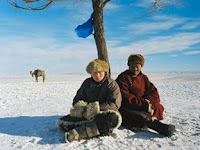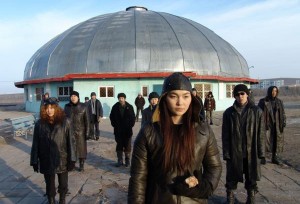Khadak — the term is a Mongolian loan word from Tibetan meaning ceremonial scarf — is a film directed by Peter Brosens and Jessica Woodworth. Brosens had already made three documentaries about Mongolia when he and Woodworth filmed Khadak, which began as a documentary about commercial aviation, and then transformed itself into a piece of magical realism about Mongolian shamanism. “Motivating the film are not only the complex economic and political manifestations of change,” the directors say, “but also the more evasive and intangible spiritual ones.”
 |
Mongolian journalist Nomin Lkhagvasuren, who assisted in the research and writing of the film script, puts the intention this way: “The very preciseness of the way the film captures Mongolian cultural expressions, beliefs and myths, the crude and beautiful reality of living, fused with essential and universal humanity … make this film a potentially unique piece of art. I envision a silence falling down upon an audience after watching the film. Silence where beauty, harmony, courage and thought translate the film into our inner universes, allowing us to open up a space and time for an inner conversation.”
And the directors add: “Yes, it is a provocative film. We offer no apologies for that. But the provocation should be perceived in a larger sense. We humans are causing so much destruction everywhere. It just so happens that this tale takes place in Mongolia and within the framework of Mongolian cosmology.”
 |
Khadak is shot on frozen steppes, in rural villages, and in the remains of the depressingly monotonous urban architecture left over from Mongolia’s Soviet era. The film tells the epic story of Bagi, a young nomad confronted with his destiny to become a shaman; his gift is the ability to hear animals over great distances. A shamaness announces that his destiny is to become a shaman, but Bagi rejects this calling, despite his grandfather warning him that denying the call brings misfortune. Soon after, a military convoy roars over the horizon. An unidentifiable plague has struck, they say — a lie fabricated in a campaign to eradicate the nomadic way of life. The animals are quarantined and slaughtered; the nomads are resettled in bleak mining towns.
In the mining town, Bagi delivers mail on a motorcycle. His grandfather, now confined to a cramped apartment, has fallen silent with sorrow; but his mother enjoys her new job operating a colossal excavator machine in the open-pit mine. When an elderly herdswoman commits suicide, Bagi and his rebellious friend, the beautiful coal thief Zolzaya, head for the big city, where they are arrested and sentenced to hard labor on a road crew of young misfits.
 |
The shamaness, who has been watching Bagi from afar, sends him into a shamanic trance, and he is committed to a hospital for people suffering from the trauma of the relocations. A psychiatrist tells him that he suffers from epilepsy and can be treated. But soon Bagi starts hearing the sounds of animals whispering through the water pipes; no one believes him, and he is put into solitary confinement, where he has his first true shamanic vision, confronted by the shamaness in a devastated futuristic city. He struggles to return to Zolzaya, leaving her mysterious signs, until there is a visionary rebellion against the oppressive forces of the industrial state.
The film is meditatively paced, with a subtle and evocative soundtrack — the sounds of water pipes, for example, slowly morphing into the barely heard cries of distant sheep. It is probably worth labeling it shamanic realism, an approach to film that made many reviewers uncomfortable. The New York Times called the film “eerie, muddled and gorgeous.” The Seattle Times speaks of the “eerie, magical quality to the political and symbolist fable,” and then finds its magical realism incomprehensible and confounding. The Oregonian finds it baffling. Every critic agrees the film is visually stunning.
Batzul Khayankhyarvaa and Tsetsegee Byamba, who play Bagi and Zolzaya, won Best Actor and Best Actress in Singapore at the First Asian Films Festival. Reviews are at Rotten Tomatoes and at IMDb. IndieWire has an interview with codirector Jessica Woodworth. And here is the trailer:
If you’re going to be in Colorado, you can catch the film at the Boulder International Film Series on February 22 and 23.

- Previous Post: The Leaf-Bundle Rattle
- Next Post: Buryat Shamanism Exhibit
- More Articles Related to: Books and Art, Indigenous Culture, Shamanism



Steve – I showed this video to my class on Ritual Studies, because much of the class is devoted to shamanism and shamanic ritual. All the students liked it, many were baffled, but what I saw in it was an attempt to create order from chaos and bewilderment (note the image of the inverted tree and the linking of numbers with realia) and shed light in a culture in which darkness reigned supreme. To me it shows that shamanic vision has this capacity, and the cadenced manner of its presentation (the music, the numbers, the silences) places it within the sphere of ritual.
Khadak is one of my favorite films… Delighted that researching it brought me to this fantastic blog!
Hi Steve
Like Jenna, I stumbled across your blog just after watching Khadak. Glad to have stumbled in this way. For me the film was very moving, and I stopped trying to work out what was real and unreal; the bafflement soon drops away and the poetry became all the more absorbing. It was a great ‘hero’s journey’; the hero crossing between life and death, this world and the spirit, to bring about a revolution through love. A great celebration of blooming hope in the young, and the wisdom in the old.